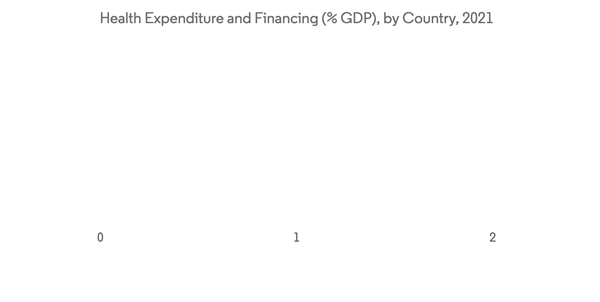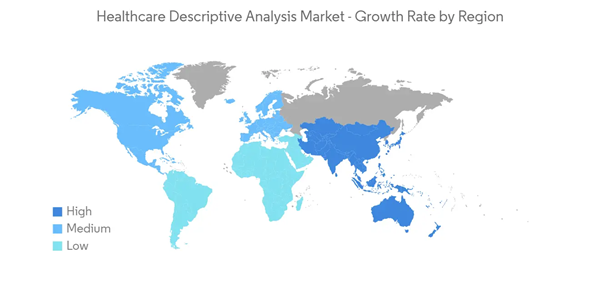The global battle against the COVID-19 pandemic benefited greatly from the use of advanced healthcare data analytics. The healthcare industry was able to track the pandemic's spread, monitor population health, predict disease severity and resulting demand, and offer the general public optimized medical solutions by utilizing data during the pandemic. According to the study published in NCBI in May 2021, calls and questionnaires were used to collect epidemiologic and disease-related data for the study, which were then descriptively analyzed. Thus, research activity increased during the pandemic, which had a big impact on market expansion. Post-pandemic, the market is seeing uniform growth due to the rising digitalization, increased adaptation of analytics, increased healthcare infrastructure, and technological advancements in healthcare descriptive analytics.
The increasing need to reduce healthcare expenditure, including the cost associated with medical product flaws and hospital workflow inefficiencies, is anticipated to increase the usage of big data in the healthcare sector. For instance, according to a study published in 'Health Informatics' in January 2021, healthcare descriptive analytics employs recent and old data to produce macro and micro insights that help in business and patient decision-making. According to the same source, the use of health data analytics allows for improvements in patient care, faster and more accurate diagnoses, preventive measures, and more personalized treatment. Such advantages of descriptive analysis in healthcare are expected to drive the market's growth.
The digitalization of healthcare data is a primary driver of the healthcare descriptive analytics market. Many developed countries are implementing electronic medical records to digitalize healthcare. For instance, the German healthcare system's largest digitalization project, the electronic patient health record (Elektronische Patientenakte - ePA), began on January 1, 2021. The ePA aims to provide extensive digital connectivity inside the German healthcare system, including between patients and clinicians, as well as between providers in hospital and primary care settings. The objective of the project is to create a central location for all patient information such as test results, diagnosis, medications, and personal health data from wearable devices. Such developments are expected to drive the market.
The rising demand for descriptive analysis in the assessment of clinical data is expected to drive the market's growth over the forecast period. For instance, in June 2021, IQVIA launched Clinical Data Analytics Suite (CDAS), a SaaS-based clinical data analytics platform that transforms clinical data analytics from descriptive reports, which improve trial safety for patients and quicken drug development. Such launches and the increased adoption of descriptive analytics in drug discovery are expected to drive the market.
However, data privacy and security concerns are expected to restrain the market's growth over the forecast period.
Healthcare Descriptive Analysis Market Trends
Cloud-based Segment Expected to Hold a Significant Share of the Market During the Forecast Period
Cloud computing has been defined as the practice of using remote servers in place of local servers or networks to store, manage, and process data. Therefore, the use of the cloud moves the data center infrastructure outside the organization.There are many advantages of cloud-based descriptive analytics in healthcare that are expected to propel the segment's growth. For instance, according to a study published in the Journal of Medical Internet Research in January 2022, the use of cloud computing involving storage and processing of data in healthcare has great potential in facilitating data-driven innovations. The cloud platforms, along with data analytics and AI, can help organizations achieve the goal of storage and processing of healthcare data. They can also help focus on patient care and security.
Several major players are making plans and launching new healthcare descriptive analysis products in the market. For instance, in March 2022, Microsoft announced the general availability of Azure Health Data Services, a cloud platform for managing and analyzing various forms of patient data. In addition, in July 2021, Amazon Web Services Inc. (AWS) reported the availability of Amazon HealthLake, a cloud-based health IT solution that leverages machine learning to extract, organize, and store structured patient health data. Such initiatives are expected to drive the market's growth.
Hence, cloud-based technologies can give users access to advanced analytics capabilities, thereby driving the segment's growth.
North America is Expected to Hold a Major Share in the Healthcare Descriptive Analysis Market
Growing federal healthcare mandates to curb rising healthcare costs and provide quality care, increasing regulatory requirements, growing EHR adoption, rising government initiatives focusing on personalized medicine, population health management, and value-based reimbursements are driving the healthcare descriptive analysis market in North America.The increasing funding from the US government for supporting healthcare is an attributing factor to the growth of the market in the United States. For instance, according to the Congressional Budget Office data published in 2021, in the past two decades, federal funding for the National Institute of Health (NIH) totaled over USD 700 billion. Thus, increasing healthcare spending in the United States is expected to boost the market due to the increased adoption of healthcare descriptive analysis in research settings.
Several companies are collaborating to support big data and improve healthcare analytics. For instance, in September 2022, Walmart entered a 10-year partnership with United Health on value-based care. To assist its physicians in providing value-based care, Walmart Health will receive analytics and decision support tools from UnitedHealth's Optum. Optum manages numerous outpatient clinics and medical practices, and it has analytics tools that collect data from payers and providers to better coordinate and deliver care. Such collaborations to provide healthcare analytics to physicians are expected to drive the market's growth in North America.
The strong foothold of key market players, increased research for the development of innovative software, and sophisticated healthcare infrastructure are also expected to drive the market in North America.
Healthcare Descriptive Analysis Industry Overview
The healthcare descriptive analysis market is moderately competitive due to the strategies adopted by key market players, such as product launches and partnerships. Some of the market players operating in the market include IBM, Inovalon, Oracle Corporation, McKesson Corporation, MedeAnalytics, Optum Inc., and Allscripts Healthcare Solutions Inc.Additional Benefits:
- The market estimate (ME) sheet in Excel format
- 3 months of analyst support
This product will be delivered within 2 business days.
Table of Contents
Companies Mentioned (Partial List)
A selection of companies mentioned in this report includes, but is not limited to:
- IBM
- Allscripts Healthcare Solutions Inc.
- Inovalon
- McKesson Corporation
- MedeAnalytics Inc.
- Optum Inc.
- Oracle Corporation
- Wipro
- Health Catalyst
- SAS Institute Inc.
- COTIVITI INC.
- CitiusTech Inc.










